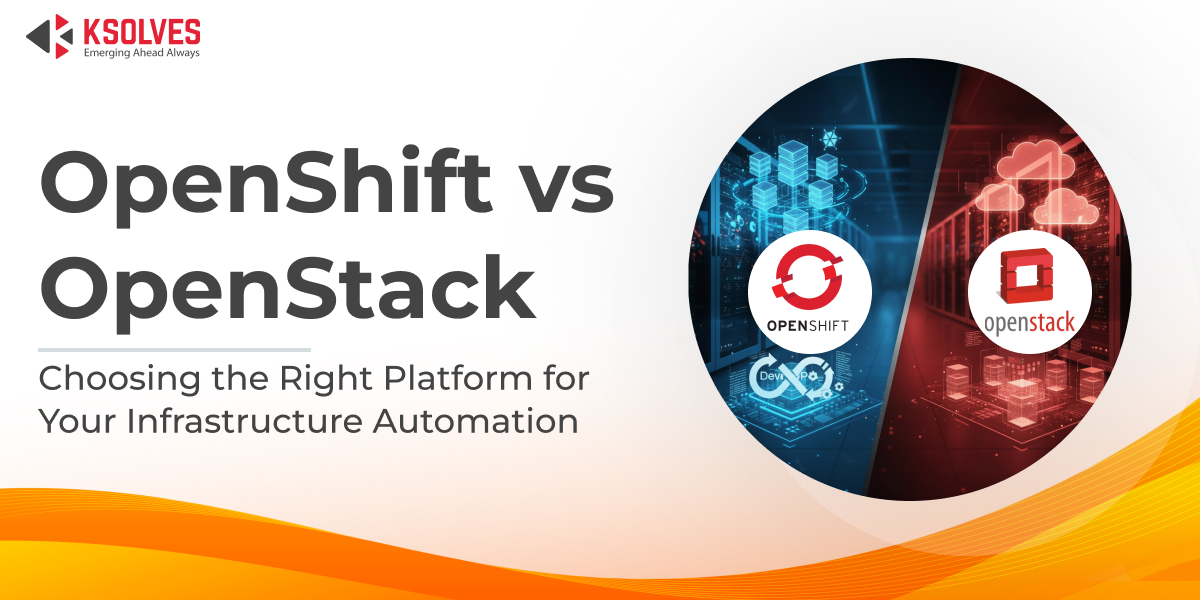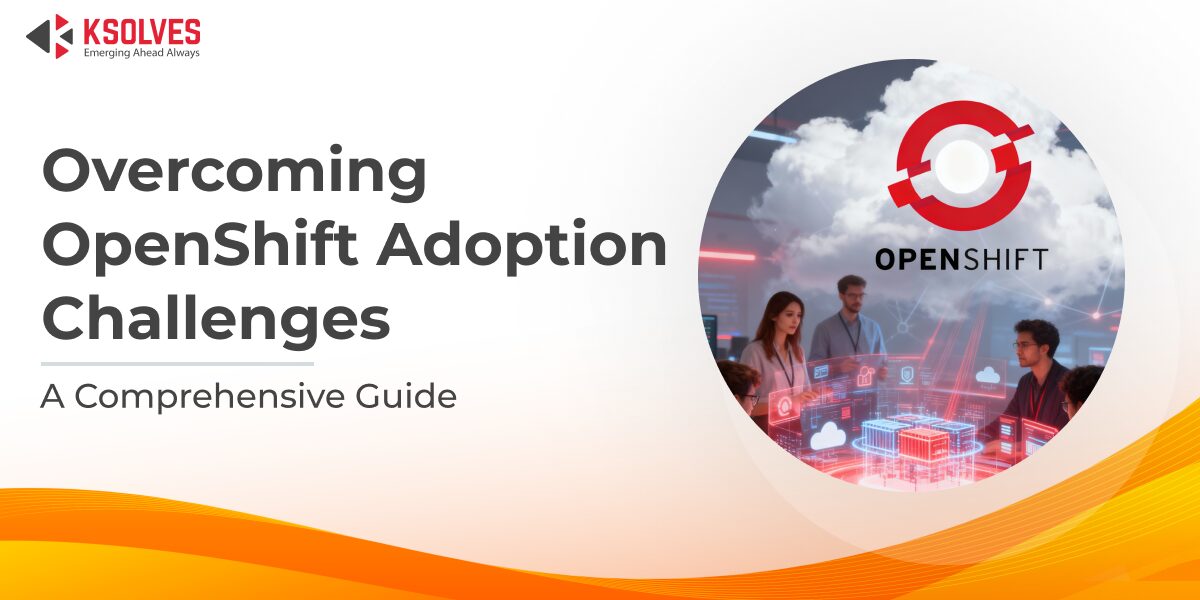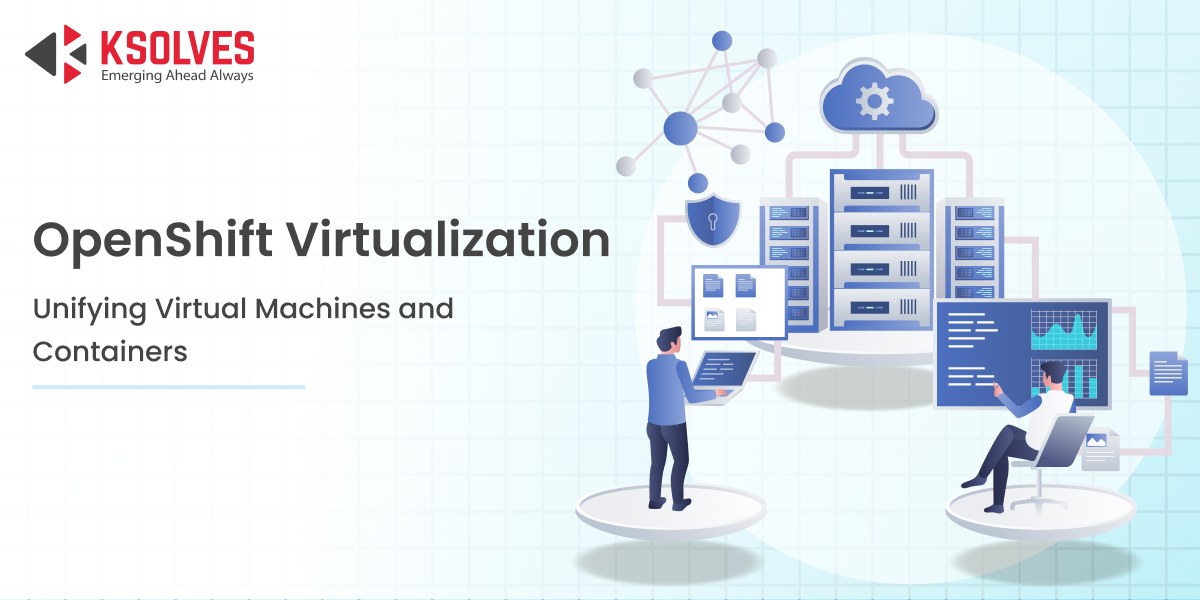OpenShift vs OpenStack: Choosing the Right Platform for Your Infrastructure Automation
OpenShift
5 MIN READ
November 19, 2025
![]()

The cloud has changed the way enterprises build, deploy, and manage IT infrastructure. What once took days of manual configuration can now be achieved in minutes through automation. But with so many technologies driving this shift, choosing the right platform for your automation goals can feel overwhelming.
Two names often surface in this conversation – OpenShift and OpenStack. Both are powerful, open-source solutions from Red Hat, and both promise agility, scalability, and control. Yet, they operate at different layers of your infrastructure stack and solve distinct challenges.
If you’ve ever wondered whether you need OpenStack, OpenShift, or both, you’re not alone. This blog breaks down their architectures, automation capabilities, and real-world use cases to help you decide which platform best fits your infrastructure automation strategy.
Understanding the Fundamentals
Before deciding which platform best fits your automation goals, it’s crucial to understand what each technology does and, more importantly, where they differ in the cloud ecosystem.
What is OpenStack?
OpenStack is an open-source Infrastructure-as-a-Service (IaaS) platform that automates the provisioning and management of core infrastructure resources – compute, storage, and networking.
In simpler terms, OpenStack helps you build and operate private or hybrid clouds. It gives enterprises the ability to manage virtual machines (VMs) at a massive scale without depending on public cloud providers.
At its core, OpenStack is composed of modular services that work together seamlessly:
- Nova: Manages compute instances (VMs).
- Neutron: Provides flexible, software-defined networking.
- Cinder: Handles block storage for persistent data.
- Keystone: Manages authentication and identity services.
- Horizon: Offers a user-friendly web-based dashboard.
By orchestrating these services, OpenStack creates a self-service, automated infrastructure layer, where IT teams can provision and scale resources dynamically.
It’s ideal for organizations that continue to run VM-based workloads but want the agility, efficiency, and elasticity of cloud automation within their own data centers.
What is OpenShift?
OpenShift, on the other hand, operates at a higher layer of abstraction. It’s an Enterprise Kubernetes Platform, often referred to as PaaS (Platform-as-a-Service) or Container Platform, that automates the deployment, scaling, and lifecycle management of containerized applications.
Built on top of Kubernetes, OpenShift extends its core capabilities by integrating:
- Built-in CI/CD pipelines for continuous integration and delivery.
- Developer-friendly tooling for faster innovation.
- Security, policy, and compliance automation built into the platform.
- GitOps and Operator frameworks for event-driven management.
Where OpenStack automates the infrastructure layer, OpenShift automates the application layer.
It empowers DevOps and platform engineering teams to build, deploy, and manage applications seamlessly across hybrid and multi-cloud environments, accelerating both development speed and operational consistency.
OpenShift vs OpenStack: A Head-to-Head Comparison
Although both OpenShift and OpenStack are open-source, enterprise-grade platforms from Red Hat, they serve distinct roles within the IT automation and cloud ecosystem.
The key difference lies in what layer of the stack they automate – OpenStack focuses on infrastructure automation, while OpenShift focuses on application automation.
| Aspect | OpenShift | OpenStack |
| Primary Focus | Automating and managing containerized applications (PaaS/CaaS). | Automating and managing infrastructure resources (IaaS). |
| Core Technology | Containers, Kubernetes, and DevOps toolchains | Virtual Machines and Software-Defined Infrastructure |
| Automation Scope | Application deployment, scaling, monitoring, and lifecycle management | Compute, storage, and network provisioning |
| Abstraction Layer | Operates at the application layer – abstracts infrastructure into containerized workloads | Operates at the infrastructure layer – abstracts physical servers into virtual resources |
| Typical Users | Developers, DevOps engineers, and platform operators | Infrastructure architects, system administrators, and cloud engineers |
| Integration Ecosystem | Integrates with Jenkins, Tekton, ArgoCD, and GitOps for CI/CD and automation | Works seamlessly with Ansible, Terraform, and Heat templates for Infrastructure-as-Code (IaC) |
| Deployment Model | Primarily Private or Hybrid Cloud deployments | Hybrid, Multi-Cloud, and Edge deployments with portability across cloud providers |
| Scalability | Scales containers and microservices dynamically through Kubernetes | Scales VMs and physical resources through orchestration |
| Security Model | Built-in DevSecOps, container security, and policy-based governance | Role-based access, Keystone identity, and network isolation |
| Resource Management | Manages application workloads and service meshes as cohesive deployments | Manages compute, storage, and networking as discrete units |
| End Goal | Application agility and innovation – faster delivery, portability, and resilience | Infrastructure agility and control – efficient use of virtualized resources |
| Ideal Use Case | Building private clouds and automating data center operations | Building and operating cloud-native, containerized applications |
| Interoperability | Can run on top of OpenStack to consume virtualized infrastructure as nodes | Can serve as the underlying infrastructure layer for OpenShift clusters |
Also Read: OpenShift vs Kubernetes: Detailed Guide
When to Choose OpenStack
Choose OpenStack if your goals revolve around:
- Automating VM-based infrastructure provisioning.
- Building a private or hybrid cloud with full control over compute, storage, and networking.
- Maintaining on-premises data sovereignty and compliance.
- Extending automation using IaC tools like Terraform and Ansible.
Example Use Case: A telecom provider building a private cloud for virtual network functions (VNFs) or enterprises modernizing existing virtualized data centers.
When to Choose OpenShift
Choose OpenShift if your goals include:
- Automating containerized application deployments and scaling.
- Implementing DevOps and GitOps pipelines.
- Enabling hybrid or multi-cloud portability.
- Accelerating application modernization with Kubernetes.
Example Use Case: A software enterprise deploying microservices-based applications across AWS, Azure, and on-premises infrastructure with automated scaling and CI/CD pipelines.
How Each Platform Handles Infrastructure Automation
While OpenStack focuses on infrastructure-level automation, OpenShift extends automation to the application and operations layers. Understanding their distinct approaches helps align your automation strategy with your organization’s architecture and modernization goals.
OpenStack’s Automation Approach
OpenStack automates the provisioning, scaling, and management of compute, network, and storage resources – transforming traditional data centers into agile, self-service clouds.
Its automation capabilities include:
- Self-Service Provisioning: Users can quickly spin up virtual machines, networks, and storage volumes on demand, reducing manual configuration overhead.
- Infrastructure-as-Code (IaC): OpenStack integrates seamlessly with tools like Ansible, Terraform, and Heat templates, enabling infrastructure definitions to be versioned, deployed, and managed through code.
- RESTful APIs: Developers and automation frameworks can programmatically control resources, allowing large-scale infrastructure management through scripts and pipelines.
- Policy-Driven Orchestration: Administrators can enforce security, quota, and compliance rules across tenants automatically.
By abstracting physical hardware into programmable resources, OpenStack standardizes and automates data center operations. Thus, it is an ideal choice for enterprises that need private or hybrid cloud infrastructure automation while continuing to rely on VM-based workloads.
OpenShift’s Automation Approach
OpenShift elevates automation to the application layer, focusing on how workloads are built, deployed, scaled, and operated across distributed environments.
It extends Kubernetes with enterprise-grade tooling, enabling complete automation across the application lifecycle.
Its automation capabilities include:
- Container Orchestration & Lifecycle Management: OpenShift automates the scheduling, scaling, and healing of containerized workloads across hybrid environments.
- Declarative Automation: Everything, from application deployments to infrastructure configurations, is defined as code, ensuring consistency and repeatability.
- Built-in CI/CD Pipelines: Integrated tools like Jenkins, Tekton, and ArgoCD streamline continuous integration and delivery workflows, reducing manual intervention.
- GitOps & Operators: OpenShift introduces GitOps-based automation and Kubernetes Operators to enable event-driven, self-healing, and policy-enforced management of complex applications.
- Policy & Security Automation: Security contexts, role-based access controls (RBAC), and network policies are enforced automatically, ensuring compliance throughout the delivery process.
This makes OpenShift the natural choice for organizations modernizing from monolithic applications to microservices-based, cloud-native ecosystems. It enables teams to focus on innovation and delivery speed, while automation takes care of reliability, governance, and scalability.
OpenShift and OpenStack Together: A Unified Automation Strategy
Rather than competing, OpenShift and OpenStack complement each other beautifully. OpenShift can run on top of OpenStack, using OpenStack’s virtual machines as the underlying infrastructure for OpenShift clusters.
This combination enables:
- End-to-end automation, from bare-metal provisioning to container deployment.
- Resource optimization, leveraging OpenStack’s elasticity and OpenShift’s application intelligence.
- Hybrid scalability, allowing workloads to move seamlessly between private and public environments.
Final Words
Both OpenStack and OpenShift play critical yet distinct roles in the cloud ecosystem. While OpenStack lays the groundwork for automated infrastructure through virtualized compute, storage, and networking, OpenShift elevates this foundation by delivering seamless application automation, scalability, and developer productivity.
At Ksolves, we empower businesses to unlock the full potential of OpenShift through our comprehensive OpenShift Consulting Services. From architecture design and containerization strategy to CI/CD automation and hybrid cloud deployment, we help you build a secure, scalable, and efficient OpenShift ecosystem. Ready to modernize your infrastructure with OpenShift?
![]()





AUTHOR
OpenShift
Share with